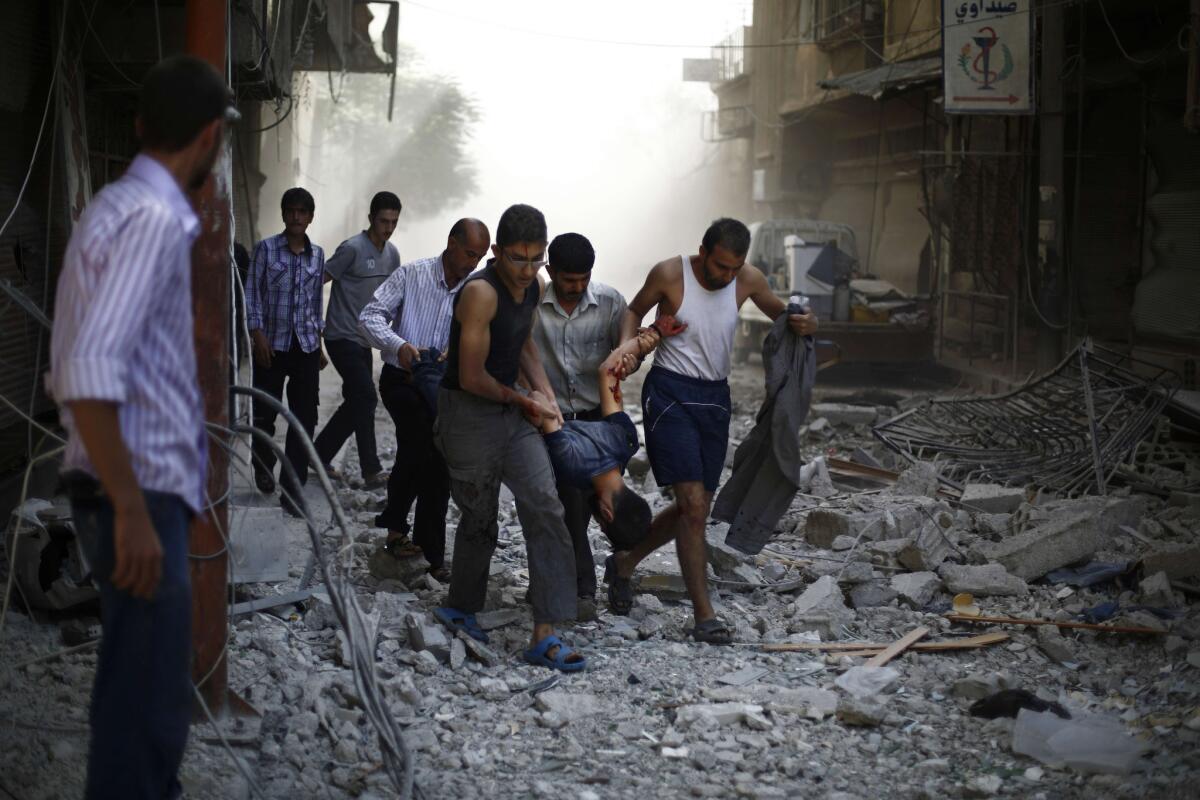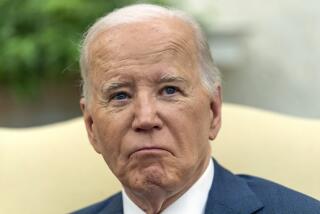Pentagon to try again at training Syrian rebels

Syrians carry a wounded man after airstrikes hit the rebel-held town of Duma in 2015.
- Share via
Reporting from Washington — President Obama has authorized a limited new plan to train and arm rebel fighters to confront Islamic State militants in Syria, relaunching a Pentagon program that was suspended last fall after a series of embarrassing setbacks.
The renewed effort, which was recommended by Defense Secretary Ashton Carter, appears far less ambitious than the original program, which aimed to train and arm 5,400 fighters a year but never achieved that goal.
“This is part of our adjustments to the train and equip program built on prior lessons learned,” said Col. Steve Warren, spokesman for the U.S.-led military coalition in Baghdad.
He said training will be focused on “select individuals in key capabilities,” and support for them “will be measured against their performance” against Islamic State.
NEWSLETTER: Get the day’s top headlines from Times Editor Davan Maharaj >>
Warren declined to say how many fighters would be trained, where the training would occur, when it would start or other details, citing operational security. The program is separate from a covert CIA-run training operation.
Warren said the new effort would “leverage the new relationships we have developed on the ground, and our approach to focus on existing groups currently active” in fighting Islamic State.
The Pentagon has struggled to find a reliable proxy force inside Syria, restricting its ability to gather intelligence and to target Islamic State leaders amid the country’s civil war.
Based in its self-declared capital of Raqqa, the Sunni Muslim extremist group continues to lure recruits and maintain strongholds despite daily airstrikes by the U.S.-led coalition since September 2014.
After the first Pentagon train and equip program was suspended in October, up to 50 special operations forces were sent to Kurdish-held areas in northeast Syria to work with local militias and identify other potential partners.
Gen. Lloyd Austin III, commander of U.S. armed forces in the Middle East, told Congress last week that the new program will use a “different approach” than the previous effort.
“We were being effective but we were slow in getting started, in generating the numbers that we needed to generate,” he told the Senate Armed Services Committee on March 8.
The original plan involved selecting fighters from moderate Syrian rebel groups, taking them to Arab military bases outside Syria, and providing arms, equipment and six weeks of training. They then would sent back to Syria to help take on Islamic State.
It was deemed a thorough failure by U.S. lawmakers and military officials.
See more of our top stories on Facebook >>
The first 54 recruits were ambushed in July by Nusra Front, an Al Qaeda affiliate, after they crossed back into Syria.
The second class of 71 surrendered much of their U.S.-issued ammunition and trucks to Nusra Front fighters in September in exchange for safe passage through northern Syria.
The program initially was envisioned as a $500-million, three-year plan to recruit, train and equip fighters at bases in Jordan, Qatar, Saudi Arabia and Turkey.
Thousands of rebels applied, but each had to be vetted in a process that often took months. Many were underage or had militant backgrounds, which made them ineligible.
In addition, the prospective host countries and many of the fighters disagreed with the U.S. emphasis on fighting Islamic State, saying the training should focus on ousting Syrian President Bashar Assad.
The Pentagon shut the program down in less than a year.
In its place, the Pentagon began providing communications equipment, weapons and ammunition to rebel commanders who had already gone through vetting and been approved.
The equipment was dropped into Syria by U.S. aircraft and distributed among the units as they pushed into territory controlled by Islamic State.
Follow @wjhenn for military and defense info.
ALSO
Pentagon skips tests on key component of U.S.-based missile defense system
Civilians are trapped and the dead lie unburied as fighting rages in Turkey’s Kurdish heartland
Chronicling a disaster: A timeline of the Syrian civil war
More to Read
Sign up for Essential California
The most important California stories and recommendations in your inbox every morning.
You may occasionally receive promotional content from the Los Angeles Times.











